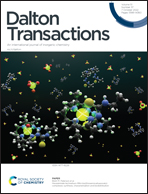Long story short: donor set symmetry in [Eu(DOTA)(H2O)]− crystals determines the electronic structure†
Abstract
Lanthanide complexes of 1,4,7,10-tetraazacyclododecane-1,4,7,10-tetraacetic acid DOTA have been studied in great detail due to their use as MRI contrast agents. Since the first report from Desreux in 1980, the Ln[DOTA]− complexes of gadolinium(III) in particular have been thoroughly investigated. The forms of the nine-coordinated [Ln(DOTA)(H2O)]− complexes are well known, and the ligand backbone has been used extensively to create functional MRI contrast agents, luminescent probes, and as a model system for studying the properties of lanthanide(III) ions. In solution, the photophysical properties have been mapped, but as the structures are not known, direct structure–property relationships have not been created. Here, the electronic properties of two Eu[DOTA] compounds (1 and 2) and a Eu[DOTA]-like compound (3) were studied using single-crystal luminescence spectroscopy. The donor set in the three compounds is identical (4N 4O 1O), and using the symmetry deviation value σideal it was shown that the coordination geometry is close to identical. Nevertheless, the electronic properties evaluated using the luminescence spectrum were found to differ significantly between the three compounds. The magnitude of the crystal field splitting was found not to scale with the symmetry of the coordination geometry. It was concluded that the donor set dictates the splitting, yet the structure–property relationships governing the electronic properties of europium(III) ions still elude us.
![Graphical abstract: Long story short: donor set symmetry in [Eu(DOTA)(H2O)]− crystals determines the electronic structure](/en/Image/Get?imageInfo.ImageType=GA&imageInfo.ImageIdentifier.ManuscriptID=D2DT02172B&imageInfo.ImageIdentifier.Year=2022)


 Please wait while we load your content...
Please wait while we load your content...